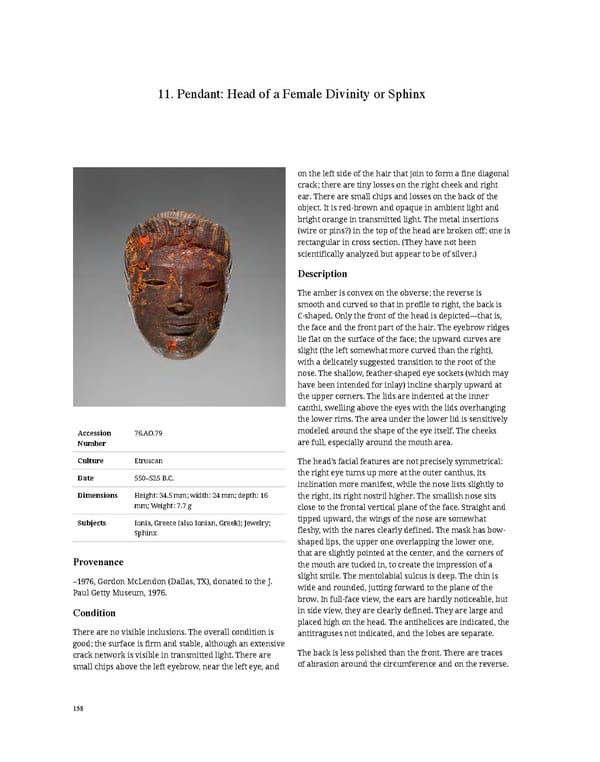11. Pendant: Head of a Female Divinity or Sphinx on the left side of the hair that join to form a fine diagonal crack; there are tiny losses on the right cheek and right ear. There are small chips and losses on the back of the object. It is red-brown and opaque in ambient light and bright orange in transmitted light. The metal insertions (wire or pins?) in the top of the head are broken off; one is rectangular in cross section. (They have not been scientifically analyzed but appear to be of silver.) Description The amber is convex on the obverse; the reverse is smooth and curved so that in profile to right, the back is C-shaped. Only the front of the head is depicted—that is, the face and the front part of the hair. The eyebrow ridges lie flat on the surface of the face; the upward curves are slight (the left somewhat more curved than the right), with a delicately suggested transition to the root of the nose. The shallow, feather-shaped eye sockets (which may have been intended for inlay) incline sharply upward at the upper corners. The lids are indented at the inner canthi, swelling above the eyes with the lids overhanging the lower rims. The area under the lower lid is sensitively Accession 76.AO.79 modeled around the shape of the eye itself. The cheeks Number are full, especially around the mouth area. Culture Etruscan The head’s facial features are not precisely symmetrical: Date 550–525 B.C. the right eye turns up more at the outer canthus, its inclination more manifest, while the nose lists slightly to Dimensions Height: 34.5 mm; width: 24 mm; depth: 16 the right, its right nostril higher. The smallish nose sits mm; Weight: 7.7 g close to the frontal vertical plane of the face. Straight and Subjects Ionia, Greece (also Ionian, Greek); Jewelry; tipped upward, the wings of the nose are somewhat Sphinx fleshy, with the nares clearly defined. The mask has bow- shaped lips, the upper one overlapping the lower one, Provenance that are slightly pointed at the center, and the corners of the mouth are tucked in, to create the impression of a –1976, Gordon McLendon (Dallas, TX), donated to the J. slight smile. The mentolabial sulcus is deep. The chin is Paul Getty Museum, 1976. wide and rounded, jutting forward to the plane of the brow. In full-face view, the ears are hardly noticeable, but Condition in side view, they are clearly defined. They are large and placed high on the head. The antihelices are indicated, the There are no visible inclusions. The overall condition is antitraguses not indicated, and the lobes are separate. good; the surface is firm and stable, although an extensive crack network is visible in transmitted light. There are The back is less polished than the front. There are traces small chips above the left eyebrow, near the left eye, and of abrasion around the circumference and on the reverse. 158
 Ancient Carved Ambers in the J. Paul Getty Museum Page 167 Page 169
Ancient Carved Ambers in the J. Paul Getty Museum Page 167 Page 169